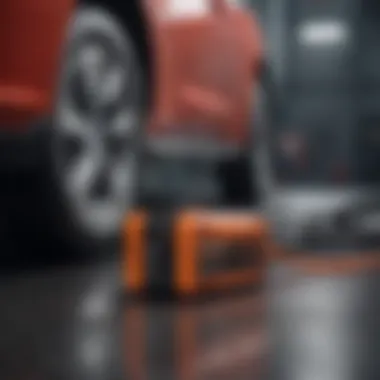Understanding Trickle Chargers for Optimal Battery Care


Intro
When it comes to keeping vehicles on the road, a car battery serves as the heart of the operation. In this realm, trickle chargers play an essential supporting role, safeguarding the health of the battery, especially in times of inactivity. This guide aims to peel back the layers of how trickle chargers work, highlighting their importance, types, and proper usage. Whether you’re a seasoned automobile enthusiast or a casual car owner, understanding these devices will provide a solid foundation for maximizing your battery's lifespan and ensuring reliable performance.
The Role of Trickle Chargers
Car batteries, much like people, need care and maintenance. A trickle charger acts as the steady friend that provides support even when there's not much going on. Unlike traditional chargers that dump a lot of power into a battery quickly, trickle chargers deliver a slow and consistent current. This gentler touch is particularly useful for batteries that may lose charge over time when a vehicle is parked for extended periods.
This is especially true for seasonal drivers who only hit the road a few times a year. A trickle charger keeps the battery topped off without the risk of overcharging—a common pitfall of faster charging methods. This method ensures that when it's time to drive, your car will start smoothly without any hiccups.
Types of Trickle Chargers
Like taking a stroll through a local farmers market, you’ll find various options when it comes to trickle chargers. Here’s a look at the different types:
Standard Trickle Chargers
These chargers are designed to work with standard lead-acid batteries. They deliver a consistent small current that can maintain battery charge without complications.
Smart Trickle Chargers
Intelligent tech has wove itself into the automotive sector. Smart trickle chargers are equipped with sensors that monitor battery levels. They adjust the output automatically based on the battery's needs, preventing issues related to overcharging.
Solar Trickle Chargers
Sustainability enthusiasts might lean towards solar trickle chargers, which utilize solar panels to recharge your battery. They’re particularly useful for outdoor vehicles like RVs or boats that might not have access to traditional power sources.
Multi-Battery Chargers
For families with multiple vehicles, a multi-battery charger allows the charging of several batteries at once. This option is convenient as it saves time and simplifies the process of maintaining different vehicles.
Advantages of Using Trickle Chargers
The benefits of integrating a trickle charger into your battery care routine extend beyond simple maintenance:
- Prolonged Battery Life: Regularly topping off your battery helps in extending its overall lifespan.
- Cost-Effective: Prevents the need for early battery replacements, saving you cash in the long run.
- Convenience: Simple to use and often allows for plug-and-forget operation.
Proper Usage Tips
To reap the rewards of a trickle charger, following best practices is key:
- Choose the Right Charger: Ensure your charger is compatible with your battery type and size.
- Set Up Safely: Place the charger in a dry area, away from moisture or dirt. Safety first!
- Connect Properly: Follow the correct connection sequence (positive first, then negative) to prevent sparks.
- Monitor Regularly: Even though trickle chargers are low-maintenance, periodic checks are a good habit.
Common Misconceptions
Despite their practicality, misunderstandings surround trickle chargers. Many believe they can only be used with older car models, but that isn’t necessarily the case. Newer cars can benefit just as much, particularly those that sit idle between uses.
Others might think any charger can serve as a trickle charger. That's not the case! Quick charging devices can actually harm batteries if left unattended, while trickle chargers are specifically designed for safe, gentle maintenance.
End
Equipped with this knowledge, car battery maintenance no longer appears as a daunting task. A trickle charger, with its thoughtful design and user-friendly operation, is a wise investment for anyone looking to keep their vehicle in tip-top shape. Ultimately, better battery care translates to enhanced performance and a smoother driving experience. This understanding paves the way for car owners and enthusiasts to make informed decisions about their vehicular care.
Prelude to Trickle Chargers
Understanding trickle chargers is crucial for anyone who relies on a vehicle. These devices help maintain a steady voltage and keep car batteries healthy during periods of inactivity. The significance of trickle chargers cannot be overstated—a well-maintained battery is essential for the reliability of your car. If you allow your battery to sit idle for too long, especially in colder months, it can become depleted. That’s where trickle chargers come in. They are designed to provide a low-level charge to your battery, preventing it from hitting rock bottom.
Definition and Functionality
A trickle charger is a specialized charger that provides a consistent, low-voltage charge to a car battery over an extended period. It’s not about fast charging but maintaining the battery’s charge levels so that it is ready to go when you are. Picture it like a trickle of water in a stream—slow, steady, and efficient. Trickle chargers are ideal for seasonal vehicles like motorcycles or classic cars that may be parked for months at a time. By keeping a constant charge, they mitigate the risk of sulfation, a major enemy of battery health.
Historical Context
Trickle charging isn't a recent discovery; its roots stretch back decades. Early automotive technology faced challenges with battery performance, especially in the wake of the widespread adoption of lead-acid batteries. Mechanics had to find solutions to combat battery degradation due to factors like repeated discharges. The trickle charger emerged as a practical tool in the mid-20th century, providing a reliable method to keep batteries topped up. As automotive technology has evolved, so too have these chargers, moving from simple devices to sophisticated units equipped with smart technology to monitor battery health.
"A well-maintained battery is not just a convenience; it's a vital part of any vehicle's operational integrity."
As we go further into this article, we will dive deeper into the mechanics behind trickle charging, the types available, and their numerous benefits. Understanding these aspects will help you appreciate the intricate ways in which these chargers contribute to the longevity and performance of vehicle batteries.
Mechanics Behind Trickle Charging
The mechanics of trickle charging play an essential role in maintaining the health of car batteries. Understanding how these devices function is crucial for anyone looking to extend battery life or avoid dead batteries altogether. This section will delve into the nitty-gritty of trickle charging, examining the operation of these chargers, the various charging cycles, and the vital voltage regulation mechanisms that ensure safe and effective charging.
How a Trickle Charger Operates
A trickle charger is essentially a low-current charger that delivers a minimal amount of current to the battery, thus keeping it at a full charge without overloading it. Unlike standard chargers that pump in a hefty amount of juice all at once, trickle chargers gently nudge the battery back to health. This is particularly important for batteries that are not used regularly, as they naturally discharge over time.
The operation of a trickle charger involves connecting it to the vehicle’s battery. Once connected, the charger assesses the battery’s voltage level. If the battery voltage is below a certain threshold, the charger kicks in to restore a full charge. Typically, it delivers approximately 1/10th of the rated battery capacity. For example, a 100 Ah battery would receive around 10 amps in a trickle mode.
Charging Cycle Explained
The charging cycle with a trickle charger is significantly different from that of traditional chargers. When charging begins, the trickle charger detects the battery's state. Initially, a low and steady current is supplied. This slow and steady process helps to revive the battery without causing excess heat or stress.
Key Phases in a Charging Cycle:
- Initial State: The charger starts by analyzing the battery voltage. If the voltage falls significantly below normal, it enters a 'charging' phase.
- Charging Phase: At this stage, the charger delivers a controlled current to the battery. The energy feeds in gently, causing minimal stress on the battery cells.
- Topping Off Stage: Once the battery nears a full charge, the charger transitions to the topping off stage. The current slowly diminishes, allowing the battery to stabilize.
This gradual process ultimately leads to enhanced battery longevity. Instead of just dumping energy into the battery, trickle chargers provide a nurturing environment that helps maintain the battery chemistry and reduces sulfation, a common issue with lead-acid batteries.


Voltage Regulation Mechanisms
Voltage regulation is a critical component of how trickle chargers operate effectively. Most modern trickle chargers feature sophisticated mechanisms that monitor and adjust voltage levels throughout the charging process. This aspect is essential for preventing damage from overcharging.
In essence, the charger acts as a gatekeeper, ensuring that voltage remains within specified limits. If the battery voltage starts climbing too high, the charger automatically reduces or cuts off the current to prevent overheating or battery damage.
Common Voltage Regulation Techniques:
- Constant Voltage Control: This method keeps the output voltage steady at a predetermined level, allowing the battery to draw only as much current as needed.
- Pulse Width Modulation (PWM): Some advanced chargers use PWM to finely tune the voltage and current, creating an optimal charging environment.
A well-functioning voltage regulation system allows trickle chargers to maintain battery health over extended periods, ensuring that batteries remain reliable and ready for use when needed.
Understanding the mechanics behind trickle charging not only highlights the convenience of these devices but also underscores their critical importance in battery maintenance. By ensuring proper operation, managing charging cycles, and regulating voltage, trickle chargers serve as a valuable ally for car owners looking to extend the lifespan of their vehicle's battery.
Types of Trickle Chargers
When it comes to maintaining car battery health, understanding the different types of trickle chargers is essential. Each type brings unique benefits and features tailored to specific scenarios and needs. This knowledge helps users pick the right device for their vehicle, ensuring optimal performance and longevity. Let’s unpack the different variants available.
Conventional vs. Smart Chargers
Conventional trickle chargers operate on a straightforward mechanism. They send a constant low voltage to the battery, often around 1-2 amps, keeping it charged. It's like setting your coffee pot to keep warming your coffee all day long – functional but not necessarily efficient. However, the trade-off is that these chargers could overcharge your battery if left unattended for too long.
On the flip side, smart chargers are the modern day heroes in this realm. These gadgets utilize more advanced technology, including microprocessors, to monitor and adjust the charging current based on the battery’s state of charge. They often switch to a maintenance mode when the battery is full, effectively preventing the dreaded overcharging situation. Imagine a thermostat that only turns on when the house gets too cold – that’s a smart charger for you.
- Benefits of conventional chargers:
- Advantages of smart chargers:
- Simplicity is key, making them user-friendly.
- Less expensive than their smart counterparts.
- Enhanced safety with built-in overcharge protection.
- Better efficiency, leading to longer battery life over time.
Solar Trickle Chargers
Solar trickle chargers incorporate solar panel technology to harness sunlight, converting it into electricity to charge car batteries. This method can be highly effective for vehicles that remain parked for extended periods, like RVs or classic cars. Using solar power not only reduces dependency on wall sockets but also contributes to a greener environment.
These chargers are particularly worth considering if you live in sunny regions or often park your vehicle outside. They also serve as excellent emergency backup methods. Just like catching rays at the beach, your battery can soak up energy and remain alive. However, do keep in mind the reliance on weather conditions.
- Key Points about solar chargers:
- Eco-friendly option, reducing carbon footprint.
- Perfect for off-grid applications.
Multi-Battery and AGM Compatibility
Not all chargers are created equal when it comes to battery types. Multi-battery chargers cater to the needs of vehicles with multiple batteries, such as boats or commercial trucks. They are designed to charge each battery independently, preventing one from drawing power disproportionately from the others, kind of like a fair split when sharing pizza at a party.
AGM (Absorbent Glass Mat) batteries have gained traction for their resilience and efficiency. Not every trickle charger supports these. Selecting the right charger is crucial, as AGM batteries require specific charging profiles to avoid damaging them. Ensure compatibility upfront to dodge potential headaches later.
- Considerations for multi-battery and AGM chargers:
- Must support specific technologies for optimal charging.
- Valuable for those with complex battery setups.
Ultimately, the type of trickle charger you select can affect not only your car’s battery health but also your convenience and peace of mind. Making a well-informed choice here ensures you avoid mishaps and get the most out of your automotive investment.
Advantages of Using Trickle Chargers
Trickle chargers have gained popularity not just for their operational simplicity but for the numerous benefits they offer to car owners. Understanding these advantages is essential, especially for those who want to maintain their vehicle battery in optimal condition. Incorporating a trickle charger into your routine ensures that your battery gets the care it needs, reducing complications and enhancing overall performance. Here are some key benefits of using trickle chargers:
Prevention of Deep Discharge
One of the primary benefits of trickle charging is its ability to prevent deep discharge in car batteries. A deep discharge occurs when a battery's voltage level drops significantly, often caused by leaving lights on or not using the vehicle for extended periods. This condition can lead to permanent damage or reduced capacity of the battery over time.
Trickle chargers deliver a low, steady charge that keeps the battery topped off, preventing it from reaching a dangerously low state. This proactive approach is particularly advantageous for owners of classic cars, recreational vehicles, or even seasonal drivers who may not use their vehicles regularly. By using a trickle charger, you mitigate the risks linked to deep discharge, promoting better battery health.
Cost-Effectiveness Over Time
Investing in a trickle charger is not merely a fleeting expenditure; it’s a wise decision that pays off over time. Maintaining a well-charged battery prolongs its lifespan and performance, which could save you a significant amount of money on replacements and repairs.
When you consider the cost involved in repeatedly replacing a failing battery, a trickle charger presents an effective solution. Additionally, the charger itself is relatively inexpensive, offering a practical and economical means of safeguarding your investment in your vehicle. In other words:
- Avoid the high costs of battery replacements.
- Save on potential breakdown or emergency service charges.
Owning a trickle charger is a simple yet effective way to keep financial overhead low while ensuring your vehicle is always ready to go.
Increased Battery Lifespan
In today's fast-paced world, maintaining the health of your battery can often be overlooked. However, using a trickle charger can significantly extend a battery's lifespan. Batteries that are regularly topped up with a trickle charger experience less stress and wear. This consistent, gentle charge helps prevent sulfation, which is the buildup of lead sulfate crystals that can occur when a battery is left discharged for too long.
Moreover, batteries are designed with a finite number of charge cycles, and trickle charging optimizes these cycles, mitigating performance degradation over time. Through careful management of their charging regimen, vehicle owners can expect their batteries to last longer, thereby reducing waste and promoting sustainability in the automotive industry.
"Regular trickle charging not only enhances performance but also supports the longevity of your battery, making it a smart investment for any automotive enthusiast."
Proper Usage Guidelines
Using a trickle charger correctly is arguably as important as the device itself. Following proper usage guidelines ensures the longevity of your battery, the safety of your vehicle, and the overall effectiveness of the charger. Neglecting these guidelines can lead to frustration and potential damage. Here, we will delve into crucial aspects including safe connections, optimal charging conditions, and maintenance tips that can significantly influence your car battery experience.


Connecting the Charger Safely
When connecting a trickle charger, safety should always take center stage. It's not just about plugging it in; it's about doing it right. First, ensure that the charger is unplugged before you make any connections. Depending on your vehicle, you may need to attach the charger to specific points such as the battery terminals. Red goes to positive and black goes to negative—a mantra that if followed, can save many a wrench throw from frustration.
Consider the connection type as well. Clamp type connections are common, but some trickle chargers offer ring terminals that allow a more permanent and safer attachment. These are particularly beneficial for those who may not be frequent charger users. Once everything is connected, it's wise to double-check the connections. A loose cable can lead to charging issues or worse, a short circuit.
Ideal Charging Conditions
Trickle chargers perform best under defined conditions. Ambient temperature plays a significant role; it's best to charge in a dry and temperate location. Extreme cold or heat can hinder the charger’s effectiveness. Placing a charger indoors—when possible—can help ensure that the surroundings do not interfere with the charging process.
Furthermore, avoid direct sunlight or areas with high humidity during charging. Ideally, look for shade if you must charge outdoors. It also makes sense to keep the battery clean. Any dirt or corrosion can impede the charging efficiency. Regular checks and a shine-up of battery terminals can go a long way in ensuring that the charging conditions remain optimum.
Regular Maintenance Tips
Equipping yourself with knowledge about regular maintenance can significantly affect your trickle charger's performance and the lifespan of your battery. First and foremost, regularly inspect the charger’s cables and connectors for any signs of wear or damage. A frayed or corroded connection can lead to inadequate charging or safety hazards.
It's also beneficial to periodically check the battery's water levels, especially if you have a lead-acid battery. Water levels should be checked monthly, and distilled water should be used to top them off. Likewise, ensure that the charger itself is kept clean. A simple wipe down with a damp cloth can remove any dirt that may have accumulated.
Lastly, consider performing a load test on your battery periodically. This will help verify its health and ensure that your trickle charger is functioning as it should. Don't overlook the manuals—both for your battery and your charger—as these often contain specific care guidelines unique to your equipment.
"Regular maintenance not only prolongs battery life but also helps you avoid unexpected surprises down the road."
Common Misconceptions About Trickle Chargers
When it comes to the realm of automotive maintenance, trickle chargers often find themselves at the center of a few misapprehensions. Many car enthusiasts and everyday drivers misunderstand the functionality and advantages of these devices, which can lead to unnecessary confusion and potentially costly mistakes. By shedding light on these misconceptions, we can better appreciate how trickle chargers play a crucial role in preserving battery health.
Trickle Charging vs. Standard Charging
To start, let's unpack how trickle charging differs from standard charging methods. Standard chargers typically deliver a higher current to the battery, enabling a relatively quick recharge. This sudden influx of power can be advantageous in situations where time is of the essence. However, it can also risk damaging the battery if not carefully monitored.
Contrast this with the trickle charger, which delivers a much slower and gentler charge, usually around 0.5 to 2 amps. *Utilizing a lower charge rate allows these chargers to maintain battery health over a long period without resulting in overheating or overloading.* Consequently, trickle chargers are ideal for batteries that are often left idle, such as those in classic cars or seasonal vehicles. They keep the battery topped off without the risk of overcharging that typically lurks with standard charging.
- Benefits of Trickle Charging:
- Considerations for Standard Charging:
- Lower risk of overheating
- Optimizes battery cycles
- Ideal for long-term storage
- Faster recharge time
- Increased risk of battery stress
- Requires regular monitoring to avoid damage
In this light, it's clear that trickle chargers serve a different purpose compared to their standard counterparts. While the latter can get you back on the road much quicker, the former is essential for long-term battery maintenance, especially for vehicles that see sporadic use.
Overcharging Myths
Another prevalent myth surrounding trickle chargers is that they can easily lead to overcharging. This stems from a misunderstanding about how these chargers actually function.
Trickle chargers are designed to offer a low level of current that matches the battery's natural self-discharge rate. When the battery reaches its optimal charge, the charger typically enters a maintenance mode. This means quiescence in the charging process, instead continuing to supply just enough power to counter the discharge that occurs naturally over time. Therefore, the notion that these chargers will continue to pump energy into the battery endlessly is misguided.
"Trickle chargers not only maintain a steady charge but also promote healthier battery performance."
For instance, modern smart trickle chargers monitor the battery's state and adjust the input as necessary, ensuring that overcharging is an issue of the past. Here are a few key points to consider:
- Smart Chargers:
- Traditional Chargers:
- Automatically adjust charge levels
- Provide a full charge without risking battery damage
- Offer indicators and alarms for monitoring status
- May require manual supervision
- Present higher risk of user error
Safety Considerations
When dealing with trickle chargers, the importance of safety can't be overstated. Understanding the potential hazards and implementing preventive measures is critical—not just for preserving the battery but also for protecting yourself and your vehicle.
Avoiding Electrical Hazards
Electrical hazards rank high on the list of safety concerns with trickle charging. Many folks might think that because trickle chargers operate at a lower voltage, they’re safe as kittens. In reality, however, neglecting basic safety precautions can lead to unpleasant surprises. Here are some crucial tips to steer clear of electrical mishaps:
- Inspect Cables and Connections: Before you plug in your trickle charger, ensure that all wires and connectors are in good shape. Frayed wires or loose connections can create short circuits or even spark fires.
- Use Ground Fault Circuit Interrupters (GFCI): If you're plugging in your charger outdoors or in a wet environment, using a GFCI can help protect against electric shock. These devices will trip and cut off the power if they detect an imbalance in the electrical current.
- Disconnect Before Adjusting: Always unplug the charger before making adjustments or enabling reconfiguration of connections. This practice greatly minimizes the risk of electrical shock while working on set-ups.
- Avoid Water: Keep the area around your battery and charger free of water. Even a small amount of moisture can cause a big problem when it comes to electricity.
Taking steps to prevent electrical hazards will not only protect you but ensure that your trickle charger works efficiently, keeping your battery in prime condition.
Environmental Safety Measures
Once the electrical safety aspects are settled, let’s not forget about our surroundings. Trickle chargers shouldn't just be safe for you; they should also be environmentally friendly. Here’s how you can ensure that the way you're using these devices won’t cause harm:
- Proper Battery Disposal: After many charges, car batteries reach the end of their lifespan. Instead of tossing them in the trash, ensure that they’re disposed of properly. Most auto parts stores or recycling centers can recycle batteries safely.
- Use Eco-Friendly Chargers: When shopping for a trickle charger, keep an eye out for models that highlight energy efficiency and minimal environmental impact. Some brands focus on sustainability, giving you peace of mind.
- Monitor Temperature Control: Trickle chargers can produce heat during the charging process. Place the charger in a cool, ventilated area to prevent overheating, which can not only degrade the charger but risk damaging surrounding materials as well.
Remember, being conscious of both electrical and environmental safety can significantly extend the life of your trickle charger and battery, making your investment work smarter for you.
By knowing and implementing these safety measures, enthusiasts can enjoy their vehicles hassle-free, leaving room for nothing but good times on the road, all while being considerate of the environment and personal well-being.
Impact of Trickle Chargers on Battery Chemistry
Understanding how trickle chargers impact battery chemistry is crucial for anyone interested in maintaining their vehicle’s performance and battery health. This section aims to shed light on how these devices interact with different battery types, enhancing their longevity while keeping safety in check. It covers two types of batteries that are very common in vehicles: lead-acid and lithium-ion. Learning how trickle chargers relate to these chemistries can help clarify their significance for automotive enthusiasts as well as everyday drivers alike.
Lead-Acid Battery Maintenance


When it comes to lead-acid batteries, often found in most traditional vehicles, a trickle charger serves an essential role. These chargers supply a low and steady current, which is especially beneficial during periods of inactivity, like long winters or when a car is parked for an extended time. This slow charge helps prevent sulfate crystals from forming on the battery plates. When sulfate builds up, it can lead to a decrease in battery capacity and overall efficiency.
A well-maintained lead-acid battery with a trickle charger can expect to see:
- Improved charge retention
- Reduction in sulfation
- Prolonged battery lifespan
Moreover, using a trickle charger can help to maintain the electrolyte levels in the battery. If the liquid dries out, it can lead to irreversible damage. Regular checks and keeping the charger connected during disuse ensures the battery remains in optimal condition, ready when you need it.
Exploring Lithium-Ion Compatibility
Lithium-ion batteries are gaining popularity, especially in electric vehicles and hybrids, thanks to their impressive energy density and lighter weight compared to traditional batteries. However, their chemistry differs significantly from lead-acid batteries. Trickle charging these batteries is a bit more intricate due to their unique charging requirements and safety considerations.
A trickle charger configured for lithium-ion requires careful attention to voltage regulation to avoid overcharging. Here are notable points about lithium-ion compatibility:
- Voltage Sensitivity: Lithium-ion batteries can easily become damaged if overcharged. Therefore, using a smart trickle charger that can adjust the voltage automatically is essential.
- Battery Management System (BMS): Most modern lithium-ion batteries come equipped with a BMS that protects against overcharging and excessive discharging. A trickle charger compatible with these systems can help maintain the battery without causing harm.
- Cut-off Voltage: Trickle chargers for lithium batteries must have a specific cut-off voltage to prevent damage.
In summary, while trickle chargers provide invaluable maintenance for lead-acid batteries by reducing sulfation and improving lifespan, when dealing with lithium-ion batteries, great care must be taken to ensure compatibility and safety. Understanding these differences is essential not just for the longevity of the batteries but for overall vehicle functionality.
Trickle charging essentially allows you to maintain your battery's health and efficiency, giving you peace of mind that your vehicle will start when you need it.
For anyone planning on using a trickle charger, understanding the distinctive chemistry of the battery in question will aid significantly in selecting the right charger and following proper maintenance protocols. This knowledge not only preserves the battery life but also enhances performance, ensuring that you are getting the most from your vehicle.
Technological Advancements in Trickle Charging
As the world of automotive technology progresses at a blistering pace, trickle chargers have not been left behind. The advancements in this domain are not just about keeping up with the changing times; they are crucial for the efficiency and longevity of car batteries. Today, modern trickle chargers incorporate several technological innovations that enhance their functionality, making them smarter and more efficient than ever before.
Smart Technology in Voltage Management
Smart technology has become a cornerstone of modern trickle chargers. These devices now feature sophisticated voltage management systems that regulate the charging process with precision. Instead of applying a constant charge, smart chargers can adjust their output based on the battery's current state. This means they can detect when the battery is fully charged and reduce the flow to a trickle, thus preventing any overcharging issues.
- Adaptive Charging: Many contemporary trickle chargers utilize algorithms that allow them to adapt to the specific needs of the battery they are charging. This adaptability can significantly impact the lifespan of the battery, as it limits exposure to high voltage levels when not necessary.
- Temperature Monitoring: Some models include temperature sensors that monitor the battery's temperature. This feature is vital since high temperatures can be detrimental to battery health. The charger can modify its function accordingly, ensuring safe operation.
- Status Indicators: Newer chargers often come with LED displays or smartphone integration, providing real-time updates on battery health. Users can track the progress without needing to constantly check on the device, which enhances its functionality in practical scenarios.
Integration with Vehicle Systems
Advancements in technology also mean that trickle chargers are now capable of integrating with the car's existing electrical systems. This integration not only simplifies the charging process but also optimizes the charging for performance.
- Onboard Diagnostics (OBD): Many modern vehicles come with onboard diagnostics systems, and compatible trickle chargers can connect to these systems to monitor battery condition comprehensively. This allows for proactive measures to be taken based on the data collected.
- Smart Connectivity: Some trickle chargers can connect with automotive applications or systems in real-time, which lets owners track charging cycles and battery health from their smartphones. This feature can be especially useful for those who want to maintain and monitor multiple vehicles at once.
- Energy Efficiency: Integration leads to a more efficient energy use since the vehicle's existing systems can provide input about the most optimum charging settings. This means that the trickle charger will only consume power when it’s necessary, saving energy and reducing costs over time.
"The evolution of trickle chargers isn’t just about batteries; it’s about smart, efficient solutions that help maintain the car's heart—its battery."
Technological advancements in trickle charging showcase a blend of innovation and practicality. By incorporating smart technology and vehicle integration, these chargers not only enhance battery longevity but also offer users a degree of ease that was previously out of reach. As we move forward, it's clear that advancements in this field will continue to pave the way for better battery maintenance solutions.
Real-World Applications of Trickle Chargers
Trickle chargers are not just a convenience but a necessity in various scenarios, especially when it comes to maintaining the health of car batteries. Understanding their practical applications highlights the crucial role they play in both everyday and specialized contexts. They ensure batteries are always on standby, preventing unexpected failure. Furthermore, they provide a sustainable approach to battery management, which can be pivotal for both casual drivers and performance enthusiasts.
Use in Racing and Performance Settings
In the high-octane world of racing, every fraction of a second counts. Here, trickle chargers serve as essential tools. Consider a typical raceday: teams rely on ensuring their vehicles are primed and ready to go. Given that many race cars sit idle for extended periods—between practice laps, qualifying, and the main event—the risk of battery drain looms large.
Trickle chargers step in as silent guardians of battery power. They maintain optimal charge levels, preventing the frustrating situation where a car fails to start due to a drained battery. For instance, top-tier racing teams utilize specialized trickle chargers that cater to their high-performance batteries. These devices often feature advanced technology that automatically adjusts output to suit the specific requirements of the battery type.
Additionally, during off-season periods, when race cars aren't in operation, trickle chargers can be left connected to the batteries, ensuring they remain charged without the risk of overcharging. The flexibility and reliability provided by these chargers are crucial—allowing cars to be race-ready at a moment's notice, saving both time and money.
Applications in Traditional and Electric Vehicles
In contrast to the racing world, trickle chargers are equally important for traditional and electric vehicles, albeit in different ways. For conventional vehicles, these chargers can be lifesavers during winter months or in regions where cars may not be used for a while. The prevention of deep discharge is paramount here. A car battery that sits unused for weeks can lose charge, leading to difficulty starting the engine when needed.
"Regular use of trickle chargers can extend the lifespan of traditional lead-acid batteries significantly, making it a smart choice for those who own older vehicles or don’t drive frequently."
On the other hand, electric vehicles leverage trickle chargers as part of a broader charging strategy. While most EV owners primarily rely on dedicated home charging stations, a trickle charger can serve as a backup, ensuring batteries remain charged, particularly when home infrastructure is limited. These chargers also allow for flexibility in charging practices; they allow owners to top up on demand, minimizing the time spent at dedicated charging stations.
Summary
Overall, the real-world applications of trickle chargers span from the track to the driveway. Their versatility proves invaluable across various scenarios, safeguarding battery life and enhancing performance. Whether it's about keeping a race car ready to zoom or ensuring an everyday driver starts without a hitch, understanding how these chargers integrate into automotive practices helps drivers and enthusiasts alike make informed decisions.
The End and Future Directions
In the realm of automotive maintenance, the role of trickle chargers cannot be understated. As we wrap up this exploration, it becomes evident that understanding how these devices function is key to maximizing vehicle battery longevity. A trickle charger serves as a silent guardian, diligently keeping batteries in optimal shape while having the capability to extend their use considerably. Whether it's for a classic car that might spend months in a garage or a daily driver needing a little extra care, trickle chargers fit right into the narrative of responsible vehicle ownership.
Summarizing Key Insights
At the heart of our discussion, several major points about trickle chargers have emerged:
- Definition and Function: Trickle chargers provide a continuous, low-level charge that prevents battery depletion without the risk of overcharging.
- Types and Technologies: Varieties like smart chargers and solar chargers cater to different needs, enhancing convenience and efficiency.
- Benefits: Regular use contributes to battery health, improved performance, and ultimately cost savings over time, as a well-maintained battery lasts longer and reduces the frequency of replacements.
- Safety Practices: Understanding how to operate trickle chargers safely ensures both effectiveness and security, minimizing hazards associated with battery maintenance.
All these insights add a layer of depth to the basic understanding of battery maintenance, proving that a little knowledge goes a long way.
Prospects for Trickle Charger Technology
Looking ahead, the evolution of trickle chargers seems promising. As technology advances, we can anticipate several noteworthy developments:
- Integration with Smart Systems: Future trickle chargers may integrate more seamlessly with vehicle onboard systems, allowing for real-time monitoring and smarter charging cycles based on driving habits and battery conditions.
- Enhanced Efficiency: As energy sources become more diversified, trickle chargers could harness solar power more effectively or utilize wind energy in suitable environments, promoting sustainability in vehicle maintenance.
- User-Friendly Innovations: With features such as mobile app connectivity, users will likely gain access to detailed analytics about their battery performance and charging cycle management.
Investing in a trickle charger today not only supports the present needs of vehicle maintenance but also aligns with future technological trends that promise to enhance battery care. As automotive enthusiasts and everyday drivers gear up for these innovations, understanding existing principles ensures they're well-prepared.
"A proactive approach to battery maintenance starts with education and appropriate tools. Trickle chargers represent that intersection of knowledge and technology, paving the way for a more sustainable automotive future."
This journey into the realm of trickle chargers has laid the groundwork for further inquiry, ensuring that both car enthusiasts and regular drivers can embrace innovative solutions that promote longevity and reliability in their vehicles.







